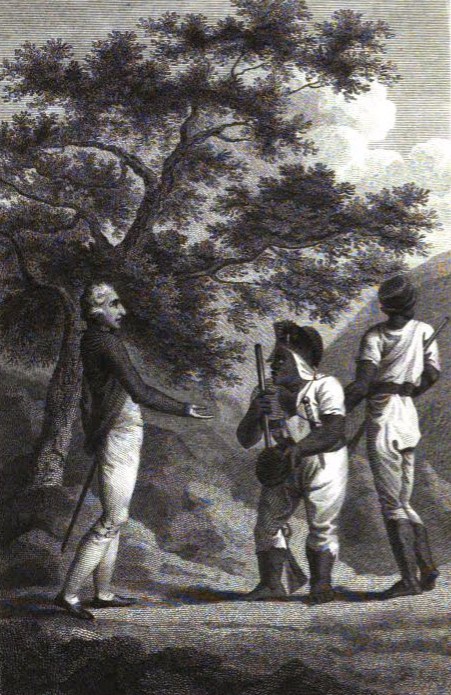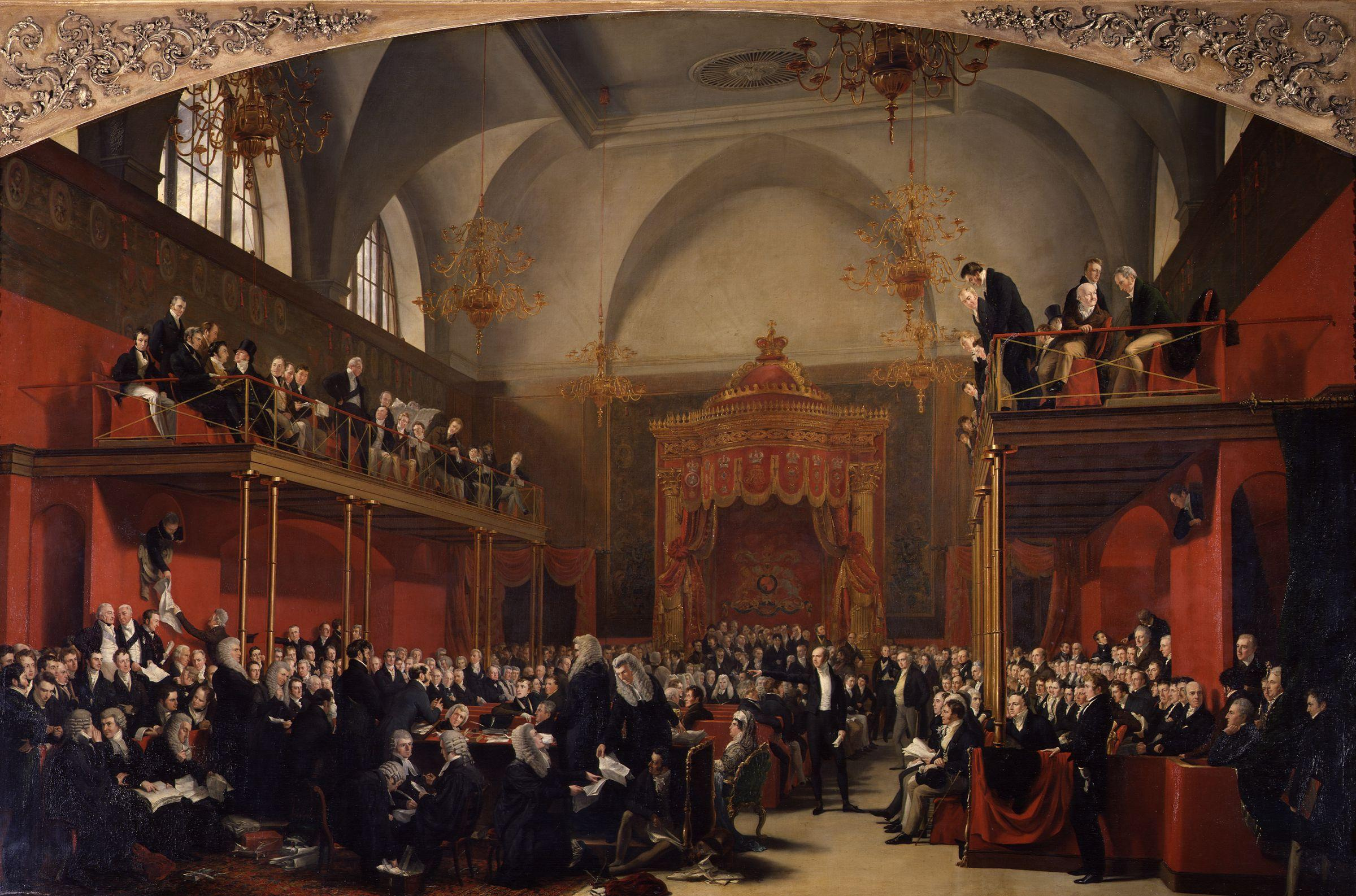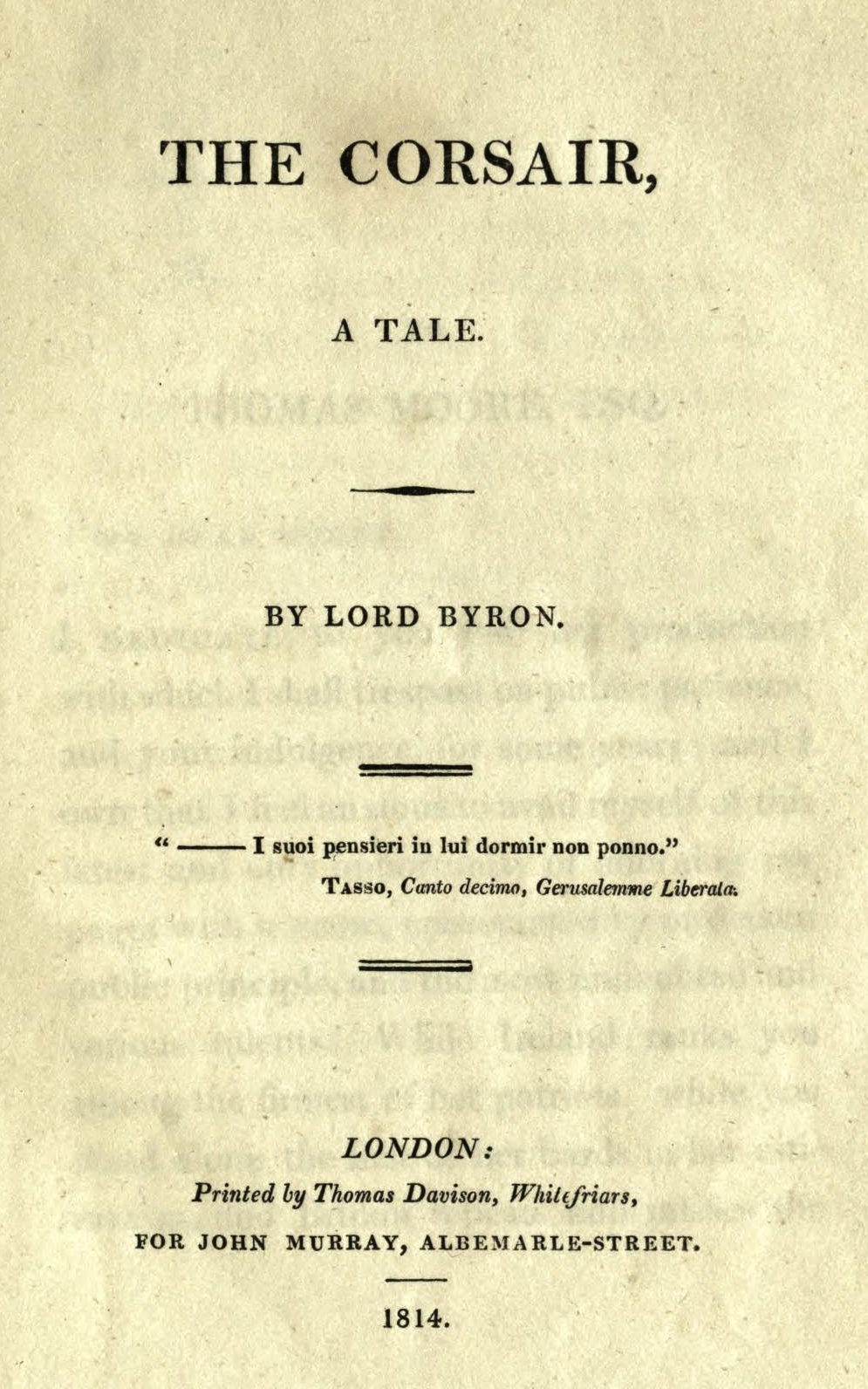|
Robert Charles Dallas
Robert Charles Dallas (1754 – 1824) was a Jamaican-born British poet and conservative writer. He is known also for a contentious book on Lord Byron, and a history of the Second Maroon War. Family Robert Charles Dallas was born in Kingston, Jamaica, where his father, Robert Dallas, M.D., of Dallas Castle, Jamaica, was a physician; his mother was a daughter of Colonel Cormack or Cammack. Dr. Robert Dallas came to Jamaica from Scotland around 1730. His first wife was Mary Frances Main, daughter of Samuel Themer Main, a merchant of Kingston. Dr Dallas then had a long-standing affair with Sarah Hewitt, née Cammack, and Robert Charles Dallas was born 14 July 1754. Sarah had previously married John Hewitt in 1751. Robert Charles was born illegitimate, and his parents eventually married in 1769, in England, after John Hewitt's death. Another son of Dr Dallas and Sarah Hewitt was Alexander J. Dallas (statesman), Alexander James Dallas. There were at least two other brothers (one possib ... [...More Info...] [...Related Items...] OR: [Wikipedia] [Google] [Baidu] |
Robert Dallas
Sir Robert Dallas, Her Majesty's Most Honourable Privy Council, PC, Serjeant-at-law, SL King's Counsel, KC (16 October 1756 – 25 December 1824) was an England, English judge, of a Scottish family. Life and career Robert Dallas was born at St Michael's, Cornhill, London. He and his brother Sir George Dallas, 1st Baronet, George were educated first at James Elphinston's school in Kensington, and then in Geneva, by the pastor Chauvet. He entered Lincoln's Inn on 4 November 1777. During this period, he honed his facility of oratory at the public debates in Coachmaker's Hall, where he was known for his extensive general knowledge and his politeness. Called to the bar on 6 November 1782, Dallas soon built a considerable practice, and specialized in parliamentary and Privy Council of the United Kingdom, privy council cases. In 1783, he was retained as junior counsel by the British East India Company to challenge the East India Bill. Dallas's most notable accomplishment, perhaps, was ... [...More Info...] [...Related Items...] OR: [Wikipedia] [Google] [Baidu] |
Jamaican Maroons
Jamaican Maroons descend from Africans who freed themselves from slavery on the Colony of Jamaica and established communities of free black people in the island's mountainous interior, primarily in the eastern parishes. Africans who were enslaved during Spanish rule over Jamaica (1493–1655) may have been the first to develop such refugee communities. The English, who invaded the island in 1655, continued the importation of enslaved Africans to work on the island's sugar-cane plantations. Africans in Jamaica continually resisted enslavement, with many who freed themselves becoming maroons. The revolts disrupted the sugar economy in Jamaica and made it less profitable. The uprisings decreased after the British colonial authorities signed treaties with the Leeward Maroons in 1739 and the Windward Maroons in 1740, which required them to support the institution of slavery. The importance of the Maroons to the colonial authorities declined after slavery was abolished in 1838. ... [...More Info...] [...Related Items...] OR: [Wikipedia] [Google] [Baidu] |
Augusta Leigh
Augusta Maria Leigh (''née'' Byron; 26 January 1783 – 12 October 1851) was the only daughter of John "Mad Jack" Byron, the poet Lord Byron's father, by his first wife, Amelia, née Darcy (Lady Conyers in her own right and the divorced wife of Francis, Marquis of Carmarthen). Early life Augusta's mother died soon after her birth. Her grandmother, Lady Holderness, raised Augusta for a few years, but died when Augusta was still a young girl, and the child divided her time among relatives and friends. Marriage Augusta later married her cousin, Lt. Colonel George Leigh (1771–1850), son of General Charles Leigh (1748–1815) and his wife, Frances Byron, her paternal aunt. The couple had seven children: Georgiana Augusta, Augusta Charlotte, George Henry, Elizabeth Medora, Frederick George, Amelia Marianne, and Henry Francis. Richard Temple-Nugent-Brydges-Chandos-Grenville, 1st Duke of Buckingham and Chandos, noted the wedding with disdain in his diary: "Poor Augusta Le ... [...More Info...] [...Related Items...] OR: [Wikipedia] [Google] [Baidu] |
The Corsair
''The Corsair'' (1814) is a long tale in verse written by Lord Byron (see 1814 in poetry) and published by John Murray in London. It was extremely popular, selling ten thousand copies on its first day of sale, and was influential throughout the following century, inspiring operas, music and ballet. The 180-page work was dedicated to Irish poet Thomas Moore. Background The poetry, divided into cantos (like Dante's ''Divine Comedy''), narrates the story of the corsair or privateer Conrad. It says that in his youth he was rejected by society because of his acts and his later war against humanity (excepting women). In this 180-page tale, the figure of the Byronic hero emerges, "that man of loneliness and mystery", who perceives himself a "villain", an anti-hero. The long poem was adapted for or inspired numerous other works in a variety of genres: the grand opera ''The Pacha's Bridal'' (1836), with music by Francis Romer and a libretto by Mark Lemon; the opera ''Il corsaro'' (184 ... [...More Info...] [...Related Items...] OR: [Wikipedia] [Google] [Baidu] |
Childe Harold's Pilgrimage
''Childe Harold's Pilgrimage'' is a long narrative poem in four parts written by Lord Byron. The poem was published between 1812 and 1818. Dedicated to " Ianthe", it describes the travels and reflections of a world-weary young man, who is disillusioned with a life of pleasure and revelry and looks for distraction in foreign lands. In a wider sense, it is an expression of the melancholy and disillusionment felt by a generation weary of the wars of the post-Revolutionary and Napoleonic eras. The title comes from the term ''childe'', a medieval title for a young man who was a candidate for knighthood. The poem was widely imitated and contributed to the cult of the wandering Byronic hero who falls into melancholic reverie as he contemplates scenes of natural beauty. Its autobiographical subjectivity was widely influential, not only in literature but in the arts of music and painting as well, and was a powerful ingredient in European Romanticism. Origins The poem contains elemen ... [...More Info...] [...Related Items...] OR: [Wikipedia] [Google] [Baidu] |
Hours Of Idleness
''Hours of Idleness'' was the first volume of poetry published by Lord Byron, in 1807, when he was 19 years old. It is a collection of mostly short poems, many in imitation of classic Roman poets. Background The volume was published in June–July 1807 as a small octavo, printed and published by S. and J. Ridge of Newark in the UK and sold by the London booksellers: Crosby and Co.; Longman, Hurst, Rees, and Orme; F. and C. Rivington; and J, Mawman. The full title was ''Hours of Idleness; a Series of Poems Original and Translated. By George Gordon, Lord Byron, a Minor.'' It consisted of 187 pages with thirty-nine poems. Of these, nineteen came from the original ''Fugitive Piece'' volume, while eight had first appeared in ''Poems on Various Occasions''. Twelve were published for the first time. The "Fragment of a Translation from the 9th Book of Virgil's Aeneid" was included as "The Episode of Nisus and Euryalus, A Paraphrase from the AEneid, Lib. 9," made up of 406 lines. After ... [...More Info...] [...Related Items...] OR: [Wikipedia] [Google] [Baidu] |
James Stephen (British Politician)
James Stephen (30 June 1758 – 10 October 1832) was the principal English lawyer associated with the movement for the abolition of slavery. Stephen was born in Poole, Dorset; the family home later being removed to Stoke Newington. He married twice and was the father of Sir James Stephen, grandfather of Sir James Fitzjames Stephen and Sir Leslie Stephen, and great-grandfather of Virginia Woolf and Vanessa Bell. Early life James Stephen was born to James Stephen and Sibella Stephen (née Milner). He began his career reporting on parliamentary proceedings for the ''Morning Post''. He was admitted to Lincoln's Inn in 1775 and was Called to the Bar there in 1782. His father had earlier been a member of the Middle Temple but was expelled before being Called to the Bar. James also read law at Marischal College, Aberdeen, for two years but ended his studies due to a lack of money. The following year he sailed with his family to the West Indies where they would live for the next 11 y ... [...More Info...] [...Related Items...] OR: [Wikipedia] [Google] [Baidu] |
Monthly Review (London)
''The Monthly Review'' (1749–1845) was an English periodical founded by Ralph Griffiths, a Nonconformist bookseller. The first periodical in England to offer reviews, it featured the novelist and poet Oliver Goldsmith as an early contributor. Griffiths himself, and likely his wife Isabella Griffiths, contributed review articles to the periodical. Later contributors included Dr. Charles Burney, John Cleland, Theophilus Cibber, James Grainger, Anna Letitia Barbauld, Elizabeth Moody, and Tobias Smollett—who would go on to establish the ''Monthly'''s competitor in 1756, ''The Critical Review''. William Kenrick, the "superlative scoundrel", was editor from 1759 to 1766. Publishing history of the ''Monthly Review'' *Volumes 1–81, May 1749–Dec. 1789; * v. 1–108, Jan. 1790–Nov. 1825; *new ser., v. 1–15, Jan. 1826–Dec. 1830; *new ser., v. 1–45, Jan. 1831–Dec. 1844. (The 4-month volumes in this series are numbered I, II, and III on the title page, restarting at I e ... [...More Info...] [...Related Items...] OR: [Wikipedia] [Google] [Baidu] |
Bryan Edwards (politician)
Bryan Edwards, Fellow of the Royal Society, FRS (21 May 1743 – 15/16 July 1800) was an English politician and historian born in Westbury, Wiltshire. Edwards supported the slave trade, and was described by Abolitionism in the United Kingdom, abolitionist William Wilberforce as a powerful opponent. Family He was the eldest son of Bryan Edwards (died 1756) and his wife, Elizabeth Bayly, sister of Zachary Bayly (planter), Zachary Bayly, a slave-owner in Jamaica. After his father's death he was supported for a time by Nathaniel Bayly, another uncle, but they fell out. His maintenance and education were then undertaken by Zachary Bayly. About 1759, Edwards joined Zachary in Jamaica, and Bayly engaged a private tutor to complete the boy's education. When Bayly died Edwards inherited his wealth, including six Jamaican plantations. In 1773 he also succeeded to the estate of another Jamaica resident, named Hume. Edwards married Martha Phipps, daughter of Thomas Phipps of Leighton House ... [...More Info...] [...Related Items...] OR: [Wikipedia] [Google] [Baidu] |
Cockpit Country
Cockpit Country is an area in Trelawny and Saint Elizabeth, Saint James, Saint Ann, Manchester and the northern tip of Clarendon parishes in Jamaica. The land is marked by steep-sided hollows, as much as deep in places, which are separated by conical hills and ridges. Maroons who had escaped from plantations used the difficult territory for its natural defences to develop communities outside the control of Spanish or British colonists. History In the late seventeenth century, the Cockpit Country was a place of refuge for Jamaican Maroons fleeing slavery. During the course of the First Maroon War, there were two Leeward Maroon communities - Cudjoe's Town (Trelawny Town) and Accompong Town. Cudjoe's Town was located in the mountains in the southern extremities of Saint James Parish, Jamaica, close to the border of Westmoreland Parish. Accompong is situated just to the south of Cudjoe's Town, on the border between Westmoreland and Saint Elizabeth Parish. When the Leeward Ma ... [...More Info...] [...Related Items...] OR: [Wikipedia] [Google] [Baidu] |
James Robertson (FRS)
James, Jim, Jimmy or Jamie Robertson may refer to: Arts and entertainment *James Robertson (photographer) (1813–1888), English photographer and gem and coin engraver * James D Robertson (1931–2010), Scottish painter and senior lecturer at the Glasgow School of Art *James Logie Robertson (1846–1922), literary scholar, editor and author *James Robertson (conductor) (1912–1991), English conductor and musical director of Sadler's Wells Opera *James Robertson (novelist) (born 1958), Scottish novelist and poet *Jamie Robertson (born 1981), film score composer from England *James Napier Robertson (born 1982), New Zealand writer, film director and producer Academia * James Robertson (orientalist) (1714–1795), Scottish minister, professor *James I. Robertson Jr. (1930–2019), scholar on the American Civil War and professor at Virginia Tech * James Burton Robertson (1800–1877), historian * J. R. Robertson (James Robert Robertson, 1867–1928), educator and Freemason in South A ... [...More Info...] [...Related Items...] OR: [Wikipedia] [Google] [Baidu] |
Hanover Parish
Hanover is a parish located on the northwestern tip of the island of Jamaica. It is a part of the county of Cornwall, bordered by St. James in the east and Westmoreland in the south. With the exception of Kingston, it is the smallest parish on the island. Hanover is the birth parish of Alexander Bustamante, labour leader, first head of government of Jamaica under universal suffrage, and one of seven Jamaican National Heroes. Its capital is Lucea. History The region was initially under Spanish control as a colony until 1655, when Spain relinquished control to the English. Over time, parishes were formed to govern the island. The parish would go unnamed for many decades even though many of the towns existed. Hanover was established on 12 November 1723. It is the smallest parish in Jamaica and was established from parts of Westmoreland and St James parishes. It was named in honor of the British monarch, George I, who was a member of the German House of Hanover. There had be ... [...More Info...] [...Related Items...] OR: [Wikipedia] [Google] [Baidu] |







